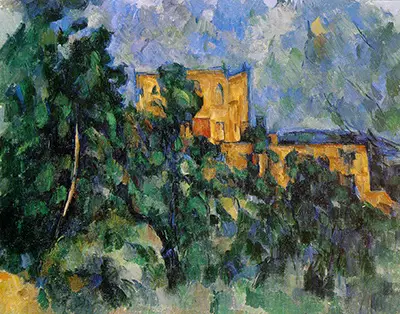Château Noir is just one example of Cezanne's love affair with the south east of France.
Cézanne had his personal workshop, L’Atelier des Lauves, at his disposal and very close to the actual Black Castle; the fact that he chose to spend countless hours painting, between 1888 and 1904, at the site of the castle and its surrounding area illustrates the fascination he held for the location.
In this work, one can perhaps observe the painter’s desire to re-invent his style, yet again. The work is neither impressionistic nor classical per se, in the tradition of an orderly and peaceful historical landscape. Here, we sense the nature in all its radical, raw energy.
Human presence is depicted too, of course, through the rigid and imposing architecture of the castle itself. Despite Man’s best efforts of building its homes and sculpting its presence within the wilderness, however, one senses that in the face of the unforgiving nature of time and the strength of the dry countryside, it is a very uneven battle indeed.
Paul Cezanne finished painting “Château Noir” in 1905, just a year before dying of Pneumonia at 67 years old. It is currently exhibited at the Museum of Modern Art in New York City.
In 1895, a first solo exhibition of Cézanne’s work was organised and held in one of the centres of the European art world: Paris. It is fair to assume that any artist, particularly after having worked prolifically for over forty years to little acclaim or recognition, would be thrilled at the prospect of attending such an event.
It could, after all, signal the break of a lifetime which most painters can only dream of, the beginning of fame and the end to precarious finances.
Cezanne, however, now well into his 50’s, was not present at the exhibition, or anywhere near Paris for that matter. He was, like every single day, in his native Provence, painting.
While he had visited and lived in Paris frequently throughout his life, especially as a young man, when the allure and excitement of the big city prove most attractive, Cezanne soon developed distaste for the Capital and its ways.
Indeed, he disapproved of what he considered to be elitism and snobbery towards artists from the countryside and styles that were not in vogue. He refused to blend in, instead returning to his native region of Provence to focus on studying and attempting to capture its beauty on canvas.
There are treasures to be taken away from this country, which has not yet found an interpreter worthy of the riches it offers- Paul Cézanne




